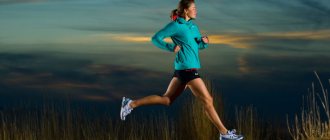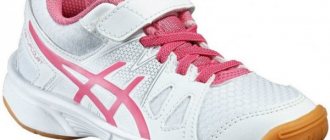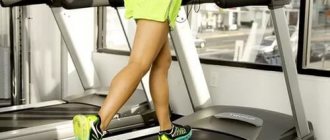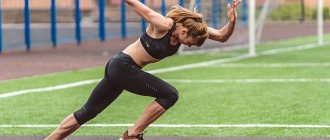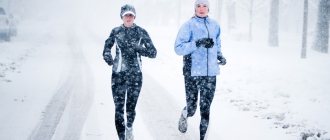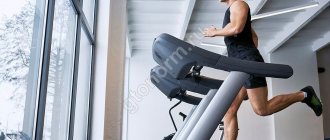Summer is over, another beach season is behind us. Someone spent it on the beach, showing off their athletic and toned body. Someone got a tan only in places not covered by clothing, hiding figure flaws. The perfect time has come to prepare your body for a new exit.
To prepare for the next season, autumn is the best time of year. Let's talk about the nuances of practicing the most famous and popular form of physical education - running. In order to start running in the fall, you don’t need much, but the main attributes are desire and equipment appropriate for the season.
Why run in the off-season?
It is believed that the running season lasts from late spring to early autumn: many races and competitions take place during this time, and it is more pleasant to run in the warm season. And the rest of the time is the so-called “off-season,” when amateurs often stop training altogether or change their sport.
However, in order for the form not to be lost and the results to not decrease, the training process must be continuous. After all, if you stop running for a month, you have to start almost all over again. And considering that at the start of a running journey you need to spend about two months developing a base, then those who started running in the summer will only begin speed work by the fall.
50 developmental exercises for training at home
Rules for running training in the off-season
If you continue to train in the off-season, it will bring many benefits:
- Firstly, the form will not be lost.
- Secondly, in the spring you can go to the first competitions already ready and at a good speed.
- Thirdly, training in the cool season can and should be devoted to eliminating those weak and problematic areas that you know about. For example, insert strength work into jogging or increase the proportion of aerobic running. In addition, many people feel uncomfortable running in the summer due to the possible heat, but in the fall the temperature seems more pleasant.
Choosing running pants Interesting facts. Interesting news
10.07.2015
It is better to run in loose shorts. However, in case of sub-zero temperatures, it is better to buy running sweatpants. According to some criteria, they resemble training options in which it is convenient to play football. Therefore, when you are fond of both running and football, you should not spend money on purchasing separate pants for each of the listed sports.
https://youtu.be/S54sSC9oxsA
The main difference between pants for running and football training is the protection the latter have. In addition, football pants have several protective plates located at the level of the knees and hips.
In this way, players are protected from damage in the event of falls and hard contact. In turn, the listed injuries are not typical for running. Moreover, the protective plates will only get in the way and weigh down your legs, which will lead to a slower run.
It is preferable to choose running items made from a material such as polyester; this version of the pants should be processed using technology that ensures heat retention.
Products with this characteristic are able to effectively remove moisture, which will protect the athlete from hypothermia. But if you jog at temperatures below 10 degrees, you should wear comfortable thermal underwear under your pants.
You should choose running pants so that they are not very spacious and, at the same time, do not press. This obliges us to find some middle ground between such extremes during the fitting process.
The main thing is that when wearing this clothing there is no feeling of physical and psychological discomfort, and nothing hinders movement.
In addition, it should be remembered that if you approach the choice of your sportswear responsibly, this can be a prerequisite for achieving good results.
Advice!
An indicator of good running pants is that they must have a strong taper from the knee. In addition, such products must have a zipper at the bottom of each leg.
Thanks to the above cut, nothing will interfere with the athlete’s movement. And the existence of a zipper will make it possible to easily remove narrow pants. To eliminate the risk of injury, it is advisable to choose pants without lacing.
It is advisable to choose a product that is held on by an elastic band.
What to run in in the fall
What you wear during a running workout depends not just on the season, but on the weather outside the window.
If we talk about layers of clothing, then when jogging there should be one less layer than if you just went for a walk. It is important to follow the principle of dressing in layers: if it gets hot, you can remove the top layer and tie it around your waist.
The main and simplest rule is to dress in such a way that it is cool at the beginning of the workout.
A rough guide to clothing for running in the fall depending on the air temperature:
+15°C and above – shorts and T-shirt.
from +10°С to +15°С – T-shirt/long sleeve and shorts.
from +5°C to +10°C – long sleeves made of functional fabric, running tights, gloves and a headband covering the ears (optional).
from -5°С to +5°С – long sleeve made of functional fabric, windbreaker/fleece jacket, tights, gloves, headband covering the ears, buff.
from -10°С to -5°С – long sleeve made of functional fabric, fleece jacket and windbreaker, tights, shorts, gloves, headband covering the ears or hat, buff.
What else can influence the choice of clothing?
- Duration: the longer the run, the warmer you should dress.
- Intensity: You can dress lighter for speed work than for cross-country running.
- Wind: Cold, biting winds are more uncomfortable than cold temperatures, so a windproof jacket can be extremely helpful.
- Rain: To avoid rainy weather as a hindrance while jogging, you should get a waterproof windbreaker.
What running pace should you choose depending on the weather?
Running on dirt in rainy weather can present the risk of slipping, falling and injury. Therefore, it is important not only to choose the right sports shoes that reduce the likelihood of falling and reliably support the foot, but also to monitor the pace of your running. It is recommended to reduce it if the weather and road are not conducive to running. If possible, it makes sense to switch to more reliable asphalt paths. For beginners, it is best to use gentle jogging tactics. You shouldn't walk home from a run. Calculate your strength so that you have enough to complete the workout with a light jog, otherwise the risk of catching a cold increases.
Text:
Layering for Fall Running
First layer
Thermal underwear or moisture-wicking clothing. Moreover, thermal underwear can be of different densities, and depending on the temperature, you can select a more or less warm option.
How to choose thermal underwear for running: a review of 10 brands
Second layer
Fleece or a jacket made of sports functional fabric, a hood may be useful.
Third layer
Protection from external factors: wind or waterproof windbreaker or vest.
Your legs get cold much less than your body, so you wear one less layer of clothing. At the same time, you can find insulated tights, and wear regular shorts over them.
How long does it take to run in the fall?
The nature of running and the duration of training is, of course, a purely individual question. But beginners should not run for more than 20 minutes at the initial stage. As your body gets used to it, you can gradually increase your workouts by a couple of minutes each time, reaching half an hour or more. In unfavorable autumn weather conditions, it is advisable that the duration of the run does not exceed one hour.
Accessories
It is best to buy gloves that are windproof and have touchscreen inserts on the fingertips. For colder weather, you can wear mittens over lightweight running gloves.
The headband must first of all protect the ears from the wind, so the material must be appropriate. It is important that it sits comfortably on your head and does not slip off your ears.
Buff or light synthetic scarf. Any option will do, but special running models are usually softer and more comfortable.
The headdress should be made of moisture-wicking, windproof and breathable fabric - this is often what sports beanie hats are made of. In warmer but rainy weather, it is convenient to wear a cap - the visor will protect your face from raindrops.
6-Week Training Plan for Your First 10K Race
Socks should cover your ankles. Compression socks are a great option for fall. For cooler weather, you can choose socks with merino wool.
How to decide whether to run in the rain or not to run
How nice it is to run in open space and fresh air. Fans of this type of jogging are looking forward to the end of the harsh winter and strive to spend time beneficial for the soul and body.
The weather is not always favorable and sometimes the question arises: “to run in the rain or not to run.”
Let cloudiness be associated with a sense of mental calm, but it can be saturated with the vital energy of running and feel an uplift in spirits.
Nevertheless, the question “to run in the rain or not to run” is quite serious, both from the side of sports and from the side of medicine. Running is a universal sport that does not require special abilities, complex equipment, or knowledge of physiology - just normal health without serious contraindications.
When choosing whether to run in the rain or not, the deciding factor may be the “greenhouse effect,” when excessive humidity is accompanied by intense heat. In such conditions, even a completely healthy person may not have enough oxygen to saturate the body.
To avoid overloading the body, it is still better to postpone training.
When thinking about whether or not to run in the rain, please note that you should initially equip yourself with the appropriate equipment for this occasion. As you yourself understand, running clothes should always be comfortable and correspond to climatic parameters so as not to freeze or overheat, which is also not very good
Attention!
The basic principle in selecting shoes is based on anti-slip soles; the upper part, accordingly, must be waterproof. The most ordinary cotton socks will give your feet comfort not only in the rain, but in any weather and will perfectly absorb excess moisture. Some simple head protection will also come in handy.
A cap is a good idea because it will protect both your eyes and your head. A little physical warming up during rain is best done indoors. If you decide to start jogging for the first time and have nothing to do with sports, then to the question “to run in the rain or not to run” there is only one correct answer - “no”.
The first time you should start with an easy jog under comfortable conditions, it is better to protect yourself from surprises and possible injuries.
Summer is more favorable to lovers of running in open areas; the weather and nature contribute to maximum physical pleasure.
It is easy to install the exercise machine in an apartment or at home. This will give you the opportunity to go for a run at any convenient time. At the same time, no one will stop you from being alone with your body in your training.
If you don't have a treadmill at hand, you can consider running in place as an option. It is less intense, but if performed correctly it will bring good physical activity to the desired muscle groups.
You can start with regular light running in place, after a while diversify it by adding a technique with raising your knees forward, then use a variant with a slight throwing of your legs back (push-off effect).
To run in the rain or not to run? We advise, but it's up to you. Have a nice run.
Finding themselves in an “interesting” situation, women accustomed to an active life are wondering: is it possible to run while pregnant? After all, as you know, sport is the key to our health. But everything can change when a representative of the fair sex carries new life within her. Pleasant position Before you find out whether you can run without…
Important!
The lesion is located on the inside of the knee joint. There are no signs of redness or swelling of the skin.
A common reason why the knee hurts after running is injury (chondromalacia patella)... Is it possible to run while menstruating? Tips and tricks
Many women today, even during menstruation, want to exercise.
However, some people worry whether physical activity is safe for the body. Is it possible to run while on your period? It is this and many other related questions that we will answer in this article. Heart tingling? Let's run to the doctor!
Surely every person knows firsthand how unpleasant it is when the heart tingles.
As a rule, with minor pain in this area, people do not make an appointment with a doctor, do not undergo an electrocardiogram, but simply take vitamin tablets, hoping that this is enough.
Running is one of the most common sports among amateurs.
With the advent of portable sound-reproducing devices, the vast majority of people running “from a heart attack” use them as musical accompaniment, which is completely justified if well-chosen music with the right rhythm turns running into a useful pleasure.
Running shoes for autumn
Contrary to the assurances of manufacturers that special autumn-winter running shoes will save you from cold and moisture, in reality this is not entirely true. They will protect from light drops of rain, but if you step in a puddle, they will still get wet. But this is not scary - after all, the feet are the last to freeze when running.
As a rule, even in sub-zero temperatures you can train outside in regular sneakers. If it's frosty outside, it will be convenient to wear running socks or socks with wool - they really warm your feet, even when they are wet.
Autumn jogging: all the subtleties and nuances of running in the fall
The cool air gently envelops you.
The aromas of a real, large forest tickle the nostrils even in the park next to the house. The legs push off slightly from the ground. Sometimes you run in such a way that it seems there are no legs, no ground, no pushes, only flight in transparent, crystal air. Regular autumn jogging is the best way to get in shape. The heat has subsided, and you will not experience any additional stress on your heart. But the intense cold has not yet taken over. For running in early autumn, you don’t even need special equipment. But many beginners get scared and leave the parks for electric treadmills. And it’s completely in vain, because it is in the fall that it is easiest to increase your speed and improve your running technique in the fresh air.
Rules for running in cool autumn weather
In addition to choosing the right equipment, it is important to follow a few basic rules so that running in cold weather does not end in hypothermia.
- It is necessary to plan the route in advance - so that the run ends in a warm room, from where you will no longer leave without changing clothes. After all, going out into the cold in clothes soaked with sweat, having already cooled down, is a sure way to catch a cold.
- If in doubt, it is better to dress a little lighter, rather than warmer: getting sweaty and getting wet in the wind is quite uncomfortable.
- If it is windy outside, try to plan your route so that you first run against the wind, and back with the wind, because the wind at your back is less felt.
- Pay due attention to accessories: these little things can make a significant difference during a run and make it much more comfortable.
Thus, there is no reason to give up running in the fall when the weather gets colder. By following a few simple rules and choosing the right clothes, you can make your workouts quite comfortable in any weather. Besides, autumn is such a beautiful time of year, and while jogging you can enjoy its special palette of colors and aromas!
However, with the onset of the cold season, many novice runners stop training for fear of getting sick.
In fact, this is a banal ignorance of the benefits of winter jogging. Scientists have proven that they are more effective than summer classes.
Benefits of winter jogging
Don't be afraid of running in the cold season. The human body is able to quickly adapt to changes in external conditions without harm to health. Scientists note two main positive factors of training in winter:
- You can stay in good shape throughout the year.
- The body will be hardened and will be less susceptible to colds.
However, running enthusiasts will have to adhere to a few simple rules to get the maximum effect. It is these that will be discussed below.
Recommendations for organizing running sessions in winter
Shoe selection
In winter, the risk of injury increases significantly as the body's stability deteriorates. To avoid problems, you need to purchase quality running shoes. When choosing shoes, special attention should be paid to the sole - it should be frost-resistant and not crack in the cold.
In addition, sneakers should have a high level of depreciation. Don't wear athletic shoes that are a size or two too big. If it fits tightly to the leg, it will be able to retain heat for a long time.
Concentrate only on training
Many people like to think about their problems while jogging. During the warm season, this may not affect safety. If you overthink it, you could slip and get seriously injured. Particular care should be taken during turns, descents and ascents. It is on these sections of the route that you can easily lose your balance.
Do a good warm-up before class
The start of every workout in any sport should be preceded by a good warm-up. Otherwise, the risk of injury increases. To warm up your muscles, just perform a few stretching movements.
Choice of clothes
In summer you can run in a T-shirt and shorts. However, such clothing is not suitable during the cold season. Choosing clothes for winter running is no less important than purchasing sports shoes. If you wear a lot of things, it will be hot and uncomfortable. The best option in this case is the principle of multi-layering. First, thermal underwear is used, and the second layer will be warm clothing that can reliably protect the body from the cold. As outerwear, it is better to use a thick jacket that does not allow moisture to pass through. It is also recommended to use a hat and gloves.
Don't try to set personal bests
It is better to set goals for improving speed or endurance in the summer. In the cold season, jogging is primarily intended to maintain fitness and improve health. Concentrate on the process of running, not on the speed of movement. The presence of a large amount of clothing and a slippery surface of the track do not contribute to improved results.
You can also reduce the intensity of your workouts. The fact is that winter jogging puts much more strain on the body compared to exercise in warm weather, and you will get tired faster. In addition, you should not stay in the cold for a long time.
Inhale air through your nose
This recommendation only looks simple. In practice, most people breathe through their mouths while running. The ideal breathing pattern is as follows:
- The air is inhaled through the nose.
- Exhalation is done through the mouth.
If you ignore this rule, you can catch a cold in the bronchi or lungs.
Skip classes if you feel unwell
If you feel unwell, it is better not to go for a run. It should also be remembered that people suffering from certain chronic ailments should not exercise outside during the cold season.
Don't run in severe frost
If the temperature outside drops below minus 20, then it is better to skip the workout. The situation is similar with a snow storm.
These recommendations will help you conduct an effective and safe exercise during the cold season.
How to choose the right running shoes for running
The best option for running is sneakers with shock absorption; they should also be elastic + soft and in no case made of leather or other substitutes that do not allow air to pass through well. It is also advisable that “Good sneakers have a service life of approximately 1000-1500 km” so that the soles have inserts that will prevent rapid wear resistance. If your sneakers have rigid elements, then this will be a plus if they are located in the heel area. As for the insoles, they must be replaceable in order to be able to replace them with orthopedic ones. By the way, your sneakers should not tire you, so choose lightweight sneakers (up to 400 grams).
Running shoes are divided into trail and asphalt. Trail shoes are "off-road" shoes, they are designed for off-road running and are equipped to do so. They have a more massive, aggressive and studded sole, a more durable upper, often with Gore-Tex and a water-repellent coating, which allows you to feel confident off-road. For training in city conditions, asphalt (road) sneakers are suitable, because their main task is to absorb shock. More expensive models are equipped with shock absorption both in the rear (heel) and in the front (toe) of the sole - this is more effective and safer for the joints.
Also, sneakers are divided according to the principle of so-called pronation. The first and almost ideal option for running is neutral pronation (when your feet are parallel when running).
The second type of pronation is hypopronation (when your toes are slightly turned inward).
And the final third option is overpronation (your toes pointing outward).
Basketball or tennis shoes, sneakers, and shoes with thin soles and without shock-absorbing inserts are not suitable for running.
Summer sneakers should be light and always have mesh so that the foot does not put too much strain and can breathe.
Winter sneakers must keep warm for a long time so that the foot does not cool down or freeze. Their material must be durable and dense.
Autumn and spring sneakers should not get wet quickly, so they should be made of denser materials. There is a special Gore-Tex fabric, thanks to which your feet will breathe and not get wet, but again, everything is relative.
Sneakers
In the fall, trail running in northern latitudes is dominated by running shoes with more aggressive soles due to the many wet and muddy areas on forest trails. City sneakers for running on asphalt remain the same as in the summer. Moreover, they continue to serve in winter; no special shoes are required, as long as the soles maintain good grip on the surface.
If you are in danger of catching a cold and getting sick when your feet get wet from running through puddles, then we can recommend wearing thermal socks or thin woolen socks. Both are capable of losing only 20% of their heat-shielding properties when wet. But most likely, such solutions are more suitable for winter, otherwise your feet will be wet simply from sweat.
We looked at the nuances of wet weather in our related post on running in the rain.
